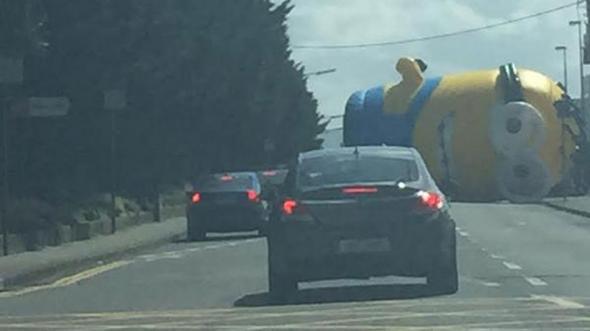The maddening assault of Minions, the squat yellow creatures starring in a film of the same name, continued this week when a giant inflatable likeness came loose and wreaked goggle-eyed havoc on a highway in Dublin, blocking cars and leaving many to wonder, What next?!
Last month, Minionese—the “language” of the overall ne’er-do-wells—generated some serious controversy after angry parents at McDonald’s stores claimed that Minions infiltrating their children’s Happy Meals were swearing. For context, here’s a video, from Instagram user mrs.cwt, of a Happy Meal Minion:
What these consumers might not know, however, is that Minions speak what director Pierre Coffin calls Minionese, which he created for the movie. Minionese consists of words from a variety of languages, mixed with grunts and growls and other vocalizations, set to a familiar cadence and delivered with intonation that allows one to pretty much get the gist of what they’re saying.* Plus, a lot of the words are simply borrowed from English (“banana” is said a lot).
In press notes published in an article on the Credits (a publication of the Motion Picture Association of America), Coffin says, “You don’t understand their words, you don’t understand their grammar, but you do understand when they’re in a position of conflict, if they’re sad or if they’re happy.” Like a silent film, it’s not too difficult to understand what’s going on simply by the expressions and emotions the Minions display, an impressive feat considering the anatomy of a Minion, which can most closely be compared to a yellow blob with an eye or two.
And while some people do create complex linguistic systems for made-up characters (Na’vi for Avatar, Dothraki for Game of Thrones, Klingon for Star Trek, and Elvish for Lord of the Rings), it’s tough to call Minionese a true language. It’s more a combination of cute and vaguely recognizable sounds strung together and delivered with such meaningful inflection that they get the message across. In press notes, Coffin said:
Every time I got stuck in a sequence or in a shot where I need to express something, I have my Indian or Chinese menu handy. I also know a little bit of Spanish, Italian, Indonesian and Japanese. So I have all these sources of inspiration for their words. I just pick one that doesn’t express something by the meaning, but rather the melody of the words.
That isn’t to say, however, that what Coffin has done and what the Minions are doing isn’t interesting. There’s now an English to Minionese translator (not endorsed by the film), which I spent a fair bit of time playing around with. “I’m hungry” apparently translates to “Het hungry,” “Are you OK?” translates to “Nama to OK?” and “What do you want to do?” is “Whaaat? batooay to quer da do?” See? A lot of English, but with some foreign or nonsense sounds thrown in to engender an air of novelty.
Similarities to English notwithstanding, it’s exciting to see movies with characters speaking in new ways! And it’s likely because of the similarities that some parents were flustered by what they heard coming from their children’s Happy Meals. Then again, according to the official back story, Minions are age-old servants of villainy and would-be traffic-snarlers. The little jerks are probably cursing at our kids.
*Correction, Aug. 4, 2015: This post originally misspelled Pierre Coffin’s last name.
